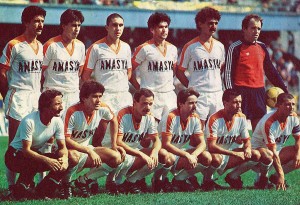Sweden. IFK Norrköping and Kalmar FF won promotion from Second Division, both teams returning to the top league.
First Division was in the second season of new formula – after the regular championship, the top 8 teams continued through direct elimination – the winner becomes champion. Hardly the best way to improve football – whoever schemed to preserve strength during the regular games and peak at the last stage had better chances. Four teams played only 22 regular season games, however. BK Häcken finished last with 12 points. Mjällby AIF was 11th with 13 points. Both were relegated.
Gefle, also with 13 points took 10th place and survived on better goal-difference.
 With 16 points, IK Brage finished 9th. The season ended for these 4 teams after the regular phase.
With 16 points, IK Brage finished 9th. The season ended for these 4 teams after the regular phase.
The top 8 continued in the direct-elimination phase after draws decided the pairs. Two legs were played all the way and luck and calculations helped: the regular part of the season was won by AIK and very confidently at that. AIK was in good shape, but reached only the semi-final. Same was the fate of the 2nd in the first phase, Malmo FF.
 Halmstads BK, 6th in the regular phase, registered the biggest loss in the elimination phase – they lost both legs to Malmo FF, the 2nd 0-6.
Halmstads BK, 6th in the regular phase, registered the biggest loss in the elimination phase – they lost both legs to Malmo FF, the 2nd 0-6.
 Hammarby IF, 5th in the first phase, was destroyed by AIK in the opening leg 2-5 and the second match was mere protocol, ending peacefully 1-1. IFK Goteborg won both legs against IF Elfsborg, orginally 7th, and Östers IF also won confidently against Örgryte IS, originally 8th .
Hammarby IF, 5th in the first phase, was destroyed by AIK in the opening leg 2-5 and the second match was mere protocol, ending peacefully 1-1. IFK Goteborg won both legs against IF Elfsborg, orginally 7th, and Östers IF also won confidently against Örgryte IS, originally 8th .
If regular season was real indication of strength, AIK and Malmo FF should have won – but they lost.
 AIK, so good and high scorers too in the opening phase, now lost the first leg to IFK Goteborg 0-3 and were unable to recover – they won 2-0 at home and the season was over. Standing from left: Rolf Zetterlund – coach, Göran Göransson, Ove Rübsamen, Göran Karlsson, Sven Dahlkvist, Thomas Johansson, Jyrki Nieminen, Björn “Lill-Garvis” Carlsson.
AIK, so good and high scorers too in the opening phase, now lost the first leg to IFK Goteborg 0-3 and were unable to recover – they won 2-0 at home and the season was over. Standing from left: Rolf Zetterlund – coach, Göran Göransson, Ove Rübsamen, Göran Karlsson, Sven Dahlkvist, Thomas Johansson, Jyrki Nieminen, Björn “Lill-Garvis” Carlsson.
First row: Ulf Sundlöf, Thomas Bergman, Björn Kindlund, Bernt Ljung, Kari Virtanen, Lars Zetterlund.
Meantime Malmö FF lost only 0-1 visiting Östers IF, but was unable to prevail at home – the match ended 1-1 and Malmö FF was out.
Östers IF and IFK Göteborg, orginally 4th and 3rd, now were going for the title. Östers IF was unable to get some advantage at home – the first leg was 1-1 tie. Which pretty much decided the championship: objectively stronger IFK Göteborg destroyed their opponent in front of joyous home supporters 3-0. Champions for a second consecutive year.
The boys also reached the Cup final, where Hammarby IF was the opposition. The final was played in Stockholm, but this was not stopping IFK Göteborg – it was not an easy win, but 1-0 was just enough.
 Hammarby IF unfortunately lost the Cup final. They were not much of a force in the championship too, but still got a spot in the Cup Winners Cup as losing finalist. Top row from left: Magnus Frykman, Jan Wegerman, Jörgen Sandell, Mats Werner, Jonnie Efraimsson, Thom Åhlund, Sten-Ove Ramberg, Thomas Dennerby, Thomas Lundin.
Hammarby IF unfortunately lost the Cup final. They were not much of a force in the championship too, but still got a spot in the Cup Winners Cup as losing finalist. Top row from left: Magnus Frykman, Jan Wegerman, Jörgen Sandell, Mats Werner, Jonnie Efraimsson, Thom Åhlund, Sten-Ove Ramberg, Thomas Dennerby, Thomas Lundin.
Middle row: Mikael Samuelsson, Sulo Vaattovaara, Michael Andersson, Mats Wahlberg, Anders Holmberg, Björn Hedenström, Per Holmberg, Per-Anders Andersson.
Sitting: Peter Gerhardsson, Kenneth Ohlsson, Anders Forsberg, Kjell Schött, ?, Bengt Persson – coach, Anders Markström, Ulf Eriksson, Tomas Turesson.
A double for IFK Göteborg – when it mattered, they played strong football. Third row, from left: Glenn Holm, Roland Nilsson, Thomas Karlsson, Ruben Svensson, Dan Corneliusson, Jan-Eric Nilsson.
Middle row: Kjell Pettersson – coach, Bengt Westerberg – coach, Per-Olof Nilsson, Stephan Kullberg, Tommy Holmgren, Jerry Carlsson, Peter Andersson
Sitting: Stig Fredriksson, Glenn Hysén, Glenn Schiller, Ove Tobiasson, Thomas Wernerson, Håkan Sandberg, Tord Holmgren, Martin Holmberg.















































